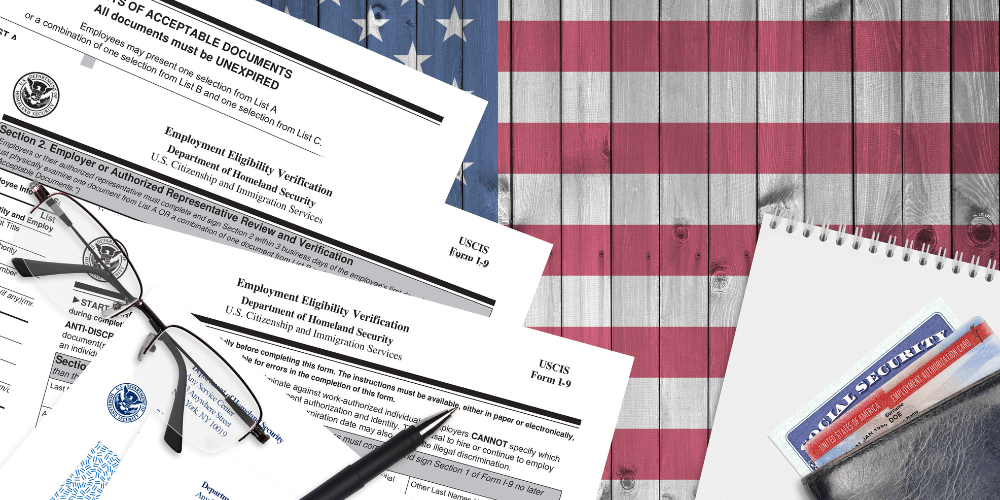Form I-9: Employer’s Guide to the Updated Employment Eligibility Form
Updated 13th January 2025 | 4 min read Published 23rd August 2023

The U.S. Citizenship and Immigration Services (USCIS) has recently unveiled an updated version of Form I-9, which is the country’s standard form for verifying employment eligibility in the U.S.
Employers Should Start Using the New Form I-9
The new I-9 form became available starting August 1, 2023. There’s a 3-month grace period, during which employers can use either the new form or the older Form I-9 (Rev. 10/21/19). The old form can be used until October 31, 2023. After the October deadline, employers could face penalties if they continue using the old form.
Alternative Ways of Reviewing Employee Documents
The U.S. Department of Homeland Security (DHS) has also recently issued a final rule permitting alternative ways of reviewing employee documents. This is in collaboration with the Form I-9 update, and will ensure the verification process is clear for employers.
The new rule allows for review methods such as remote document examination. There’s a box on the updated Form I-9 where employers can indicate how documents were examined. The space on the form lists all DHS-authorized alternative review methods.
DHS has stated that only employers in good standing and using e-Verify can conduct verification electronically. This remains unchanged as of August 1, but the framework is in place to expand electronic verification at some future date.
According to Hinshaw & Culbertson attorney Ian Wagreich, the process of electronic verification also remains unchanged at this time. Verification requires a live video meeting with the employee, obtaining and keeping copies of the verified employee documents, and a new E-Verify case for each new employee.
Understanding the Updates to Form I-9
The updated Form I-9 consists of two sections. Employers will notice many similarities, but there are some important differences. It’s important to be familiar with the new form.
The updated form consists of two sections and two supplements:
- Section 1: Collects an employee’s basic identifying information, and requires that they attest to their status within the U.S. (i.e. U.S. citizen, noncitizen national, noncitizen authorized to work, lawful permanent resident). This section is completed at the time of hire.
- Section 2: Collects original documents showing the employee’s identity and employment authorization. The employer is to review these and keep copies on file. This can be completed within three days of hire.
- Supplement A: Used when translators or preparers assist with completing Section 1.
- Supplement B: Used when employment authorization needs to be reconfirmed. Should be completed for rehires, name changes, and if authorization will expire.
Both sections and any required supplements have to be kept on file for the duration of employment, plus the required post-employment retention period. (The retention period is the latter of 3 years after the hire date or 1 year after the end date.)
Should the DHS, the Department of Labor, or the Department of Justice request to see an employee’s forms, they must be furnished. Civil penalties, and occasionally criminal penalties, can be assessed If forms are unavailable or not provided.
The Changes to Updated Form I-9
The notable changes on the updated Form I-9 include
- Sections 1 and 2 are reformatted so they’re on a single-sided sheet. Fields weren’t removed, but some were merged in the reformatting.
- Supplement A has taken the place of Section 1 Preparer/Translator Certification. This and other supplements can be attached as needed.
- Supplement B has taken the place of Section 3 Reverification and Rehire. This can be attached as needed.
- “Noncitizen authorized to work” has replaced “alien authorized to work.” The difference between “noncitizen national” and “noncitizen authorized to work” is clarified.
- The form is now compatible with smartphones and tablets, which is important if using remote verification.
- Certain fields and the requirement for “N/A” have been removed, to make downloading easier.
- The discrimination avoidance notice has been updated.
- The List of Acceptable Documents has been updated.
- A new box must be checked if using a DHS-authorized alternative review method.
Some updates have also been made to the instructions:
- Shortened to 8 pages rather than 15 pages.
- Some definitions have been added.
- The steps for each section have been streamlined.
- A new instruction for the alternative review was added.
- Removed abbreviations charts.
Get Help With Employee Onboarding
We’re constantly updating our onboarding services to meet legal requirements and industry best practices. Learn more about our onboarding services today.
DISCLAIMER: The information provided herein does not constitute the provision of legal advice, tax advice, accounting services or professional consulting of any kind. The information provided herein should not be used as a substitute for consultation with professional legal, tax, accounting, or other professional advisers. Before making any decision or taking any action, you should consult a professional adviser who has been provided with all pertinent facts relevant to your particular situation and for your particular state(s) of operation.




